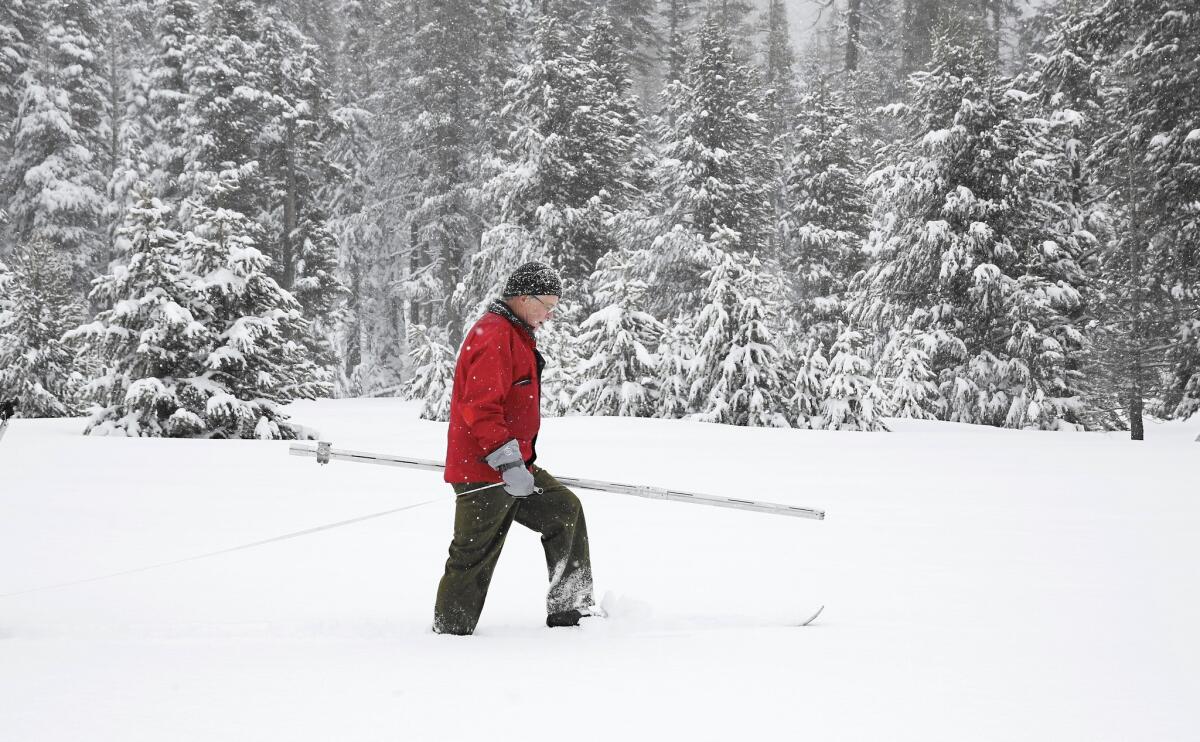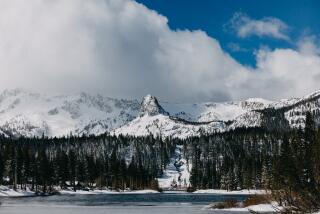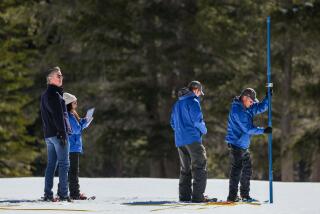In Northern California, skiers and water officials are grateful for the recovering snowpack

- Share via
Reporting from Donner Summit, Calif. — Here at one of the snowiest places in the country, Ed Bischoff marveled at a view that had been absent for years.
A number of early winter storms, strengthened by El Niño conditions, had covered the northern Sierra Nevada in white. Fresh snow weighed down towering evergreens along Interstate 80. On local roads, street signs peeked out of snowbanks more than 7 feet high.
Bischoff remembered the drive to Sugar Bowl ski resort last year, when the landscape was mostly dirt. The only snow was man-made — narrow strips of powder on the slopes that had managed to stay open.
Water and Power is The Times’ guide to the drought. Sign up to get the free newsletter >>
“There was no snow on the road, no snow anywhere until you got here,” he said, gazing up at the mountains he had frequented for years. “It was all brown everywhere.”
Across Northern California, skiers and water officials are heartened by the recovering snowpack, which last year had amounted to 5% of its normal water content — the lowest in 500 years, based on studies of tree rings.
It’s so good to see all the snow piled up around here. We’re way ahead of last year, and it’s only going to get better.
— Janet Tuttle, Donner Ski Ranch
“Five percent,” David Rizzardo, chief of snow surveys and water supply forecasting for the Department of Water Resources, recalled with awe. “There’s only five other numbers that could be lower than that. It knocked the record out of the books.”
The record low had prompted statewide drought emergency measures and forced ski resorts to shut down early.
Now, with the state’s snowpack averaging 94% of normal for this time of year, officials are cautiously optimistic this winter could offer a measure of drought relief. In January alone, Sacramento had 17 days of rain. Squaw Valley, site of the 1960 Winter Olympics, has seen more than 26 feet of snow this winter — 40% more than the total for all last season, from November to May. Going into March, there’s a good chance most of California will see above-average precipitation, climate experts said.
But judgment day is not until April 1, when officials start calculating just how much snow might be available to supply California’s water demands over the summer and fall.
The recent storms in Northern California are promising, officials said, but precipitation in most other parts of the state is still below average. In Southern California, under blue skies and soaring temperatures, drought-anxious residents continue to wonder if El Niño is real.
Still, any precipitation up north, where the snowpack and major reservoirs are located, bodes well for the entire state, officials said. For Northern Californians, the memory of a rainless, snowless January 2015 still stings.
Some resorts in the Lake Tahoe area were already closed by this time last year.
“The snow stopped, and it started getting really warm. We were doing our best, but it was tough. The snow was so thin. Just brown spots everywhere,” said Janet Tuttle, who runs Donner Ski Ranch with her husband, Marshall. “For us, a little family-owned ski resort, the numbers just didn’t add up.”
Making snow is expensive, she said. And getting the water to make the snow would’ve been another challenge. So the Tuttles closed last year on Jan. 19, after only 44 days of skiing.
This year, Tuttle is optimistic that come April, she’ll still be busy. On a recent Wednesday, the parking lot was full by midmorning, the ski lift churning hundreds of visitors up the mountain. Tuttle’s wooden lodge, built in 1937, bustled with families bundling their kids up for a day of lessons in the snow.
“It’s so good to see all the snow piled up around here,” Tuttle said. “We’re way ahead of last year, and it’s only going to get better.”
Water officials are also banking on more snow in the coming months. Rizzardo, the snow survey chief, scrutinizes the numbers each day like the statistics for a fantasy football team.
To come close to digging California out of the drought, he estimated, the full Sierra range needs 150% of its average by April — an ambitious benchmark even with all the precipitation so far this winter. As of Thursday, the northern Sierra measured 97% of average for this time of year; the central Sierra 96% of average; and the southern portion 87%.
“We’re over here cheering. It’s like your team’s gunning for the playoffs and they’re doing good,” Rizzardo said. “But we’ve got to pick up the pace a little bit if we want to get to that 150%.”
Join the conversation on Facebook >>
Ski resorts celebrate snowfall in inches and feet, but Rizzardo cares about the water content. Powder is less preferable than dense, slushier snow, or what he calls “Sierra cement.”
Daily reports come in from a sweeping network of about 125 automated snow sensors — large aluminum pillows that are placed on mountains across the state. When snow falls on the pillow, the weight compresses a fluid inside, sending the information to a device that calculates how much water it contains.
Rizzardo also works with data from about 240 “snow courses” — specific spots in open meadows where officials trek each month to manually measure the water content. Some of these stations have been around for more than a century, providing one of the most comprehensive climate records in California.
Together, these data points help provide a statewide average. Looking at only one of these stations could be misleading, Rizzardo said. Phillips Station, for example — where Gov. Jerry Brown stood last April in a field devoid of snow — is now 130% of normal for February. But the statewide snowpack is still 6 percentage points below average.
The data help Rizzardo’s team create weekly and monthly forecasts that influence this year’s water allocations. He understands that farmers, local officials, environmentalists and boaters follow these reports religiously, but cautioned that forecasts can be as fickle as Mother Nature.
“It’s this puzzle that’s constantly changing on you,” he said. “We’ll drive ourselves crazy [rewriting forecasts] all the way into June.”
And though it’s important to have snow banked for the summer, Rizzardo said any precipitation this year — whether it’s rain or early melting snow — will help fill the state’s drought-parched reservoirs. New Melones in the central Sierra foothills, for example, is still at 18% of capacity.
“The key right now is reservoir storage,” he said. “So however the water makes its way in there, we’re quite happy to catch it.”
For Brennan Best, who works at Sugar Bowl and spends his time fishing and hiking around Lake Tahoe, any precipitation is a boost to his community’s way of life. Last year, instead of snowboarding after work, he resorted to rock-climbing in areas that usually were not accessible until late spring.
“This year, I couldn’t even get into the zones,” he said, laughing. “There’s too much snow.”
He said last year was depressing. Tahoe, the largest alpine lake in North America, had stopped flowing into the Truckee River when it dropped below its natural rim. Recharged by snowmelt, the lake started rising this winter and the river looks like a river again.
“It’s a different world up here than it was,” Best said. “It’s been great to just actually have a real winter and be really excited about Tahoe again.”
Twitter: @RosannaXia
ALSO
Latinos seek answers from Sanders and Clinton in Las Vegas
Manny Pacquiao posts Bible verse that states gay people should be killed
Change in bullet train construction plans will delay rail line’s arrival in Southern California







